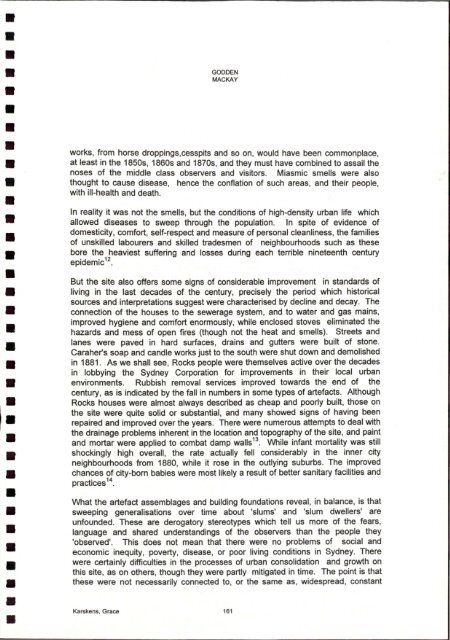Private Pleasures
Private Pleasures
Private Pleasures
You also want an ePaper? Increase the reach of your titles
YUMPU automatically turns print PDFs into web optimized ePapers that Google loves.
GODDEN<br />
MACKAY<br />
works, from horse droppings,cesspits and so on, would have been commonplace,<br />
at least in the 1850s, 1860s and 1870s, and they must have combined to assail the<br />
noses of the middle class observers and visitors. Miasmic smells were also<br />
thought to cause disease, hence the conflation of such areas, and their people,<br />
with ill-health and death.<br />
In reality it was not the smells, but the conditions of high-density urban life which<br />
allowed diseases to sweep through the population. In spite of evidence of<br />
domesticity, comfort, self-respect and measure of personal cleanliness, the families<br />
of unskilled labourers and skilled tradesmen of neighbourhoods such as these<br />
bore the heaviest suffering and losses during each terrible nineteenth century<br />
epidemic 12 .<br />
But the site also offers some signs of considerable improvement in standards of<br />
living in the last decades of the century, precisely the period which historical<br />
sources and interpretations suggest were characterised by decline and decay. The<br />
connection of the houses to the sewerage system, and to water and gas mains,<br />
improved hygiene and comfort enormously, while enclosed stoves eliminated the<br />
hazards and mess of open fires (though not the heat and smells). Streets and<br />
lanes were paved in hard surfaces, drains and gutters were built of stone.<br />
Caraher's soap and candle works just to the south were shut down and demolished<br />
in 1881. As we shall see, Rocks people were themselves active over the decades<br />
in lobbying the Sydney Corporation for improvements in their local urban<br />
environments. Rubbish removal services improved towards the end of the<br />
century, as is indicated by the fall in numbers in some types of artefacts. Although<br />
Rocks houses were almost always described as cheap and poorly built, those on<br />
the site were quite solid or substantial, and many showed signs of having been<br />
repaired and improved over the years. There were numerous attempts to deal with<br />
the drainage problems inherent in the location and topography of the site, and paint<br />
and mortar were applied to combat damp walls 13 . While infant mortality was still<br />
shockingly high overall, the rate actually fell considerably in the inner city<br />
neighbourhoods from 1880, while it rose in the outlying suburbs. The improved<br />
chances of city-born babies were most likely a result of better sanitary facilities and<br />
practices 14 •<br />
What the artefact assemblages and building foundations reveal, in balance, is that<br />
sweeping generalisations over time about 'slums' and 'slum dwellers' are<br />
unfounded. These are derogatory stereotypes which tell us more of the fears,<br />
language and shared understandings of the observers than the people they<br />
'observed'. This does not mean that there were no problems of social and<br />
economic inequity, poverty, disease, or poor living conditions in Sydney. There<br />
were certainly difficulties in the processes of urban consolidation and growth on<br />
this site, as on others, though they were partly mitigated in time. The point is that<br />
these were not necessarily connected to, or the same as, widespread, constant<br />
Karskens, Grace 161




